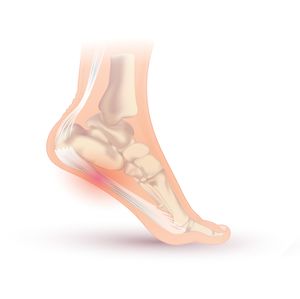Baxter's Nerve Entrapment
Introduction[edit | edit source]
The most common complaint in the foot and ankle region is heel pain. The most of these problems, however, are related to plantar fasciitis. [1]Up to 20% of cases of chronic heel pain are caused by Baxter's nerve entrapment. However, it's an often-overlooked source of heel pain.[2]
Anatomy[edit | edit source]
Baxter’s nerve, is the first branch of the lateral plantar nerve. lateral plantar nerve has sensory components to the calcaneal periosteum, the long plantar ligament and the lateral plantar skin, and motor fibers to the abductor digiti minimi, flexor digitorum brevis and quadratus plantae. The first branch of the lateral plantar nerve originates from the lateral plantar nerve near the bifurcation of the tibial nerve or it may arise from the tibial nerve prior to its bifurication. It then dives through the superficial fascia at the superior border of the abductor. At this level, the investing fascia of the abductor is thicker laterally because of the reinforcement from the interfasicular ligament in continuity with the medial intermuscular septum. It travels distally between the lateral abductor fascia and the medial edge of the quadratus. When it reaches the lower border of the abductor hallucis, it turns and courses laterally, passing 5.5 mm anterior to the medial calcaneal tuberosity (or spur) and between the quadratus and the underlying flexor brevis until it reaches its distal target of the abductor digiti minimi.[2]
Etiology[edit | edit source]
Baxter's nerve is vulnerable to entrapment because of its course, and the most common location is the tight fascia of the abductor hallucis and the medial aspect of the quadrates plantae muscle. However, two point have been proposed as possible entrapment reasons.
- The first is the point where the nerve turns laterally between the medial edge of the quadratus plantae and the thick lateral fascia of the abductor hallucis.
- The second is the point where the nerve courses anterior to the tuberosity and/or spur. An increase in cubic contact of this passage (via a spur or muscle hypertrophy) and/or pronation of the rearfoot/midfoot complex, causing impingement at the nerve’s sharp turn are both possible predisposing conditions.[2]
Diagnosis[edit | edit source]
- Subjective assessment
- Objective assessment
- Examinations
- Radiography and Bone scan
- Serologic testing
Differential diagnosis[edit | edit source]
- Plantar fasciitis
- Seronegative arthritis-induced inflammation
- Tarsal tunnel syndrome
- Medial calcaneal neuritis
- Heel spurs
- Trauma
- Fat pad atrophy
- Calcaneal stress fractures
- Periosteal inflammation
References[edit | edit source]
- ↑ Sahoo RK, Peng PW, Sharma SK. Ultrasound-Guided Hydrodissection for Baxter’s Neuropathy Secondary to Plantar Fasciitis: A Case Report. A&A Practice. 2020 Nov 1;14(13):e01339.
- ↑ 2.0 2.1 2.2 Stephen Offutt DP, Patrick DeHeer DP. How to address Baxters nerve entrapment. Podiatry Today. 2004 Nov 3;17(11).







